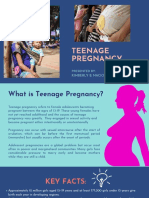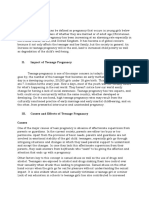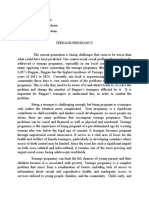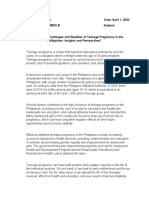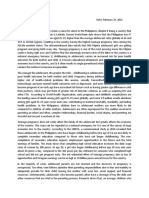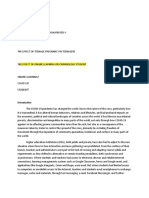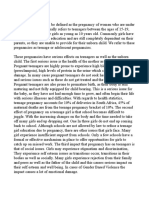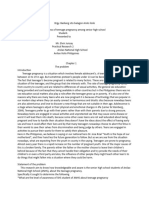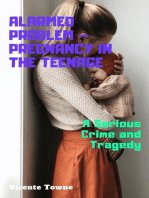Professional Documents
Culture Documents
Researchaaengmod 5
Researchaaengmod 5
Uploaded by
jamyka tanOriginal Description:
Original Title
Copyright
Available Formats
Share this document
Did you find this document useful?
Is this content inappropriate?
Report this DocumentCopyright:
Available Formats
Researchaaengmod 5
Researchaaengmod 5
Uploaded by
jamyka tanCopyright:
Available Formats
JAMYKA B.
TAN 10-CHARITABLE ENGLISH
ASSESSMENT MS. EDUARTE MODULE 5
NO TO TEENAGE PREGNANCY
TOPIC: Teenage Pregnancy
I. What is Teenage Pregnancy?
A. Teenage pregnancy is defined as a teenage girl, usually within the ages of 13-19,
becoming pregnant. The term in everyday speech usually refers to girls who have not
reached legal adulthood, which varies across the world, who become pregnant.
However, it can include girls as young as ten.
B. Data of teenage pregnancy around the world.
According to official data of World Health Organization, every year, an estimated
21 million girls aged 15 to 19 years, and 2 million girls aged under 15 years
become pregnant in developing regions. Approximately 16 million girls aged 15
to 19 years and 2.5 million girls under 16 years give birth each year in developing
regions. Complications during pregnancy and childbirth are the leading cause of
death for 15 to 19 year-old girls globally. Every year, some 3.9 million girls aged
15 to 19 years undergo unsafe abortions. Adolescent mothers (ages 10 to 19
years) face higher risks of eclampsia, puerperal, and systemic infections than
women aged 20 to 24 years, and babies born to adolescent mothers face higher
risks of low birth weight, preterm delivery, and severe neonatal conditions than
those born to women aged 20 to 24 years.
C. Data of teenage pregnancy in the Philippines.
The teenage pregnancy rate in the Philippines was 10% in 2008, down to 9% in
2017. Live births by teenage mothers (aged 10-19) in 2016 total 203,085, which
slightly decreased to 196,478 in 2017 and 183,000 in 2018. Still, the Philippines
has one of the highest adolescent birth rates among the ASEAN Member States
(UNFPA). In 2019, adolescent births (below 18 years old) were at 62,510. It
dropped to 56,428 in 2020. The country's baseline target in the Philippine
Development Plan by 2022 is 37 births per 1,000, while POPCOM aims to reduce
teenage births by half, using the baseline of 57 percent teen births on the 2013
National Demographic Health Survey to 28 percent by 2022.
D. Why is it important to talk about teenage pregnancy?
Children are sexualized human beings, and it is important for them to
understand the sexual nature of their bodies. Sexuality education plays a very
significant role in the lives of both boys and girls in the prevention of HIV
and/or AIDS, sexually transmitted infections, as well as Teenage pregnancy.
Teenage pregnancy carries other significant non-health risks which are specific to
this stage in the life course. For example, when a teenager bears a child and
consequently either marries formally or enters into a consensual union, she puts
herself at risk of not finishing her education and of limiting her chances of
realizing her full potential by being burdened with child care when she herself is
still, almost a child. If the teenager remains unmarried following a pregnancy, she
risks social stigma from having an out-of-wedlock pregnancy and of having to
bear its negative consequence. Thus Teenage pregnancy is very serious problem
so it is important to talk about.
II. Is teenage pregnancy Is a social problem?
A. Why teenage pregnancy is a social problem?
Teenage pregnancy is thus frequently both a marker of early social and economic
disadvantage and a source of additional disadvantage, emotional and physical
health problems. When compared to their peers, teen mothers are more likely to
be living on lower incomes, with lower educational attainment, and difficulties
with housing and family conflicts.
B. How does teenage pregnancy affect the society?
Teen pregnancy is a public health issue that affects all of us. A teenager who has a
baby is more likely to face critical social challenges such as poverty, poor
education, risk - taking behaviors that lead to poor health, and youth development.
III. What are the reasons/causes of teenage pregnancy?
A. Teenagers are especially susceptible to peer pressure. They also lack the
necessary education to make an informed sexual decision. Teenage pregnancy
risks increase dramatically when teenagers lack access to informative
reproductive resources, sexual health services, and other educational counseling.
The more informed they are, the better prepared they will be to avoid accidents
and make sound decisions.
Along with a lack of education, teenagers face a unique set of challenges that are
often linked to teen pregnancy. These include:
- Alcohol and drug use
- Lack of knowledge about contraception or sex
- Low self-esteem
- Lack of future goals
- Sexual activity at a younger age
- Sexual abuse victims
- Poor performance in school
- Negative attitude about contraception
Poor peer relationships, sexually active friends, dating older people at a younger
age, and peer pressure to engage in sexual activity are all social risk factors. With
all of these issues bombarding teens on a daily basis, it's often difficult to resist
the pressure.
Teen pregnancy risks can also be increased by poor family circumstances.
Teenagers with better parental relationships are more likely to discuss sex and get
the information they need to avoid pregnancy. Those who are afraid of their
parents are at a much greater risk. Other concerns include:
- Negative interactions with family
- Poor or limited parental supervision
- Family history of teen pregnancies
- Single-parent families
- Significant unresolved conflict between family members
Some teenagers are vulnerable to rape and sexual abuse. Without contraception or
protection, these occurrences can also lead to teenage pregnancy.
IV. What are the effect of teenage pregnancy in our health?
A. Although the female body can reproduce and give birth as soon as menstruation
begins, this does not imply that a teen is emotionally, mentally, and/or physically
prepared. Teens who become pregnant before the age of 15 are at risk for anemia,
premature birth, low birth weight, higher infant mortality rates, pregnancy-
induced hypertension/high blood pressure, and the possibility of the baby's head
being larger than the pelvic opening. This can lead to complications during the
birthing process.
While pregnant, teenagers may experience depression and poor nutrition. If they
have more than one sexual partner or have not been practicing safe sex, they may
be at risk for sexually transmitted diseases, which can be harmful to the baby if
left untreated.
V. How to prevent teenage pregnancy?
A. Reduce Adult Discomfort with their own and adolescent sexuality.
- Raise community awareness that research is clear that there is no correlation
between sexuality education and increased rates of intercourse.
B. Develop a family approach to teenage pregnancy prevention promote healthy
sexuality.
- Provide sexuality education at all levels, including sessions for parents, peer
group activities and programs for young children.
- Recognize the association between child abuse/child sexual abuse and teen
pregnancy and work to develop prevention and intervention programs.
C. Promote caring, consistent adult involvement for every child.
- Parents must be educated about the importance of their consistent involvement
in their children’s lives.
- Provide extra-curricular activities at a school and other community sites,
involving adults from the community as volunteer coaches, counselors, and
mentors.
D. Build healthy communities through sound economic and social development.
E. Promote media responsibility and counteract negative media images.
- Encourage broadcast and print media to take responsibility for establishing
ethical standards regarding both advertising and editorial portrayals of sexual
images of boys and girls, women and men, and sexuality and violence.
F. Teenagers must have a thorough understanding of abstinence, contraceptive
methods, and consequences in order to prevent teenage pregnancy.
REFERENCES:
Taylor, Rebecca. Buffum (2020, June 08) Teenage Pregnancy. www.webmd.com
Jones, Laure. (2021, January 22) What are the main causes of teenage pregnancy.
www.parentology.com
Cudis, Christine. (2022, March 9) POPCOM lauds LGUs’ initiatives to mitigate teen pregnancies.
www.pna.gov.ph
Adolescent pregnancy child watch (1996) Teenage pregnancy prevention.
www.facebook.com/profile.php?id=100080051169073
You might also like
- BSM Bohol Research EditedDocument78 pagesBSM Bohol Research EditedBal Ri MekoleuNo ratings yet
- Communication Plan (Djalene Toledo)Document9 pagesCommunication Plan (Djalene Toledo)Djalene ToledoNo ratings yet
- Teenage Pregnancy: Kimberly B. NacionDocument19 pagesTeenage Pregnancy: Kimberly B. NacionKim Nacion100% (4)
- Chapter 1 3Document24 pagesChapter 1 3Kyzia Cassandra De JuanNo ratings yet
- UntitledDocument2 pagesUntitledKrayjin F. SpardaNo ratings yet
- Open The Door To SafetyDocument11 pagesOpen The Door To SafetySheena Marie M. TarleNo ratings yet
- ProjectDocument6 pagesProjectVicxie Fae CupatanNo ratings yet
- Project Adolescent PregnacyDocument12 pagesProject Adolescent PregnacyDaniela BaezNo ratings yet
- Submit By: Sagun Abygail L. Submit To: Mrs. Daisy Oandasan Grade & Strand: Grade 11-StemDocument4 pagesSubmit By: Sagun Abygail L. Submit To: Mrs. Daisy Oandasan Grade & Strand: Grade 11-StemkreiNo ratings yet
- English Research - Group6Document9 pagesEnglish Research - Group6Aezen HanamiyaNo ratings yet
- Teenage Pregnancy Brief DiscussionDocument3 pagesTeenage Pregnancy Brief DiscussionJoanna Peroz100% (1)
- Blue White Aesthetic Minimalist Thesis Defense PresentationDocument8 pagesBlue White Aesthetic Minimalist Thesis Defense PresentationsamymbongNo ratings yet
- Teenage PregnancyDocument7 pagesTeenage PregnancyRuzzel Mae Saile CodillaNo ratings yet
- Chapter2The Cause and e-WPS OfficeDocument9 pagesChapter2The Cause and e-WPS OfficeJomer TamayoNo ratings yet
- Lennel Tobol EMTECH CONCEPT PAPERDocument10 pagesLennel Tobol EMTECH CONCEPT PAPERCarrel KuunNo ratings yet
- What Causes Teenage Pregnancy?Document2 pagesWhat Causes Teenage Pregnancy?Queen Ella BiscochoNo ratings yet
- Ama Computer Learning Center - Northbay Senior High SchoolDocument7 pagesAma Computer Learning Center - Northbay Senior High Schoolxylie dumpNo ratings yet
- Aspectos SocialesDocument4 pagesAspectos SocialesGuru RachellNo ratings yet
- Teenage PregnancyDocument3 pagesTeenage PregnancyCherrylou Buday100% (1)
- TARALADocument35 pagesTARALAMeynard MagsinoNo ratings yet
- Teenage MommiesDocument6 pagesTeenage MommiesLeslie VillegasNo ratings yet
- Teenage Pregnancy 2Document22 pagesTeenage Pregnancy 2Falusi Blessing OlaideNo ratings yet
- UntitledDocument12 pagesUntitledYamaguchi KumikoNo ratings yet
- Teenage Pregnancy Is The Biggest Problem Women and Girls Face in The PhilippinesDocument3 pagesTeenage Pregnancy Is The Biggest Problem Women and Girls Face in The PhilippinesVon VeraNo ratings yet
- Aaa SN PsycDocument2 pagesAaa SN Psyckingawesome21No ratings yet
- Inbound 836121531699490140Document19 pagesInbound 836121531699490140Hazzelle Joy OlibacNo ratings yet
- Teenage PregnancyDocument27 pagesTeenage PregnancyMaricel Ceyh GonzalesNo ratings yet
- Chapter 1Document4 pagesChapter 1Ronald Pacquiao MacaseroNo ratings yet
- Advocacy in Child CareDocument17 pagesAdvocacy in Child Careapi-85429702No ratings yet
- Chapter 1Document4 pagesChapter 1Faisal Tuazon IINo ratings yet
- Practical Research 1Document6 pagesPractical Research 1Dimple JsjsjNo ratings yet
- Research Argumentative EssayDocument6 pagesResearch Argumentative EssayHoney LabajoNo ratings yet
- Activity 6 Teenage PrenancyDocument2 pagesActivity 6 Teenage Prenancychuchaylopez7No ratings yet
- Teenage PregDocument19 pagesTeenage PregJefferson Beralde100% (1)
- Final Written Resaerch Report. JOHRYL ANDRADADocument12 pagesFinal Written Resaerch Report. JOHRYL ANDRADASANNY OMELANo ratings yet
- Chapter 1-1Document8 pagesChapter 1-1Caroline ValenzuelaNo ratings yet
- Pregnancy 2 (1) .OdtDocument9 pagesPregnancy 2 (1) .Odtsonika nayarNo ratings yet
- Sex Educ and Teen PregnancyDocument10 pagesSex Educ and Teen PregnancyBoy Kakak Toki0% (1)
- Impact of TeenaDocument8 pagesImpact of TeenaLaarni CampoNo ratings yet
- Teenage PregnancyDocument5 pagesTeenage PregnancyDavid VenturaNo ratings yet
- Teenage PregnancyDocument12 pagesTeenage PregnancyMaebelle Tambo-ongNo ratings yet
- Teenage Pregnancy Is Not A BlessingDocument15 pagesTeenage Pregnancy Is Not A BlessingEryll Eunice VillaganasNo ratings yet
- Teen Pregnancy NotesDocument11 pagesTeen Pregnancy NotesChristine De Villa-RagudoNo ratings yet
- Analytical Paper: Submitted By: Via Bianca Laisa 11 - St. CatherineDocument3 pagesAnalytical Paper: Submitted By: Via Bianca Laisa 11 - St. Catherineyuya laisaNo ratings yet
- Adol PregDocument3 pagesAdol PregaqlhndzrhNo ratings yet
- The Significance of Sex Edu WorldwideDocument2 pagesThe Significance of Sex Edu WorldwideNANCY HILBY100% (1)
- A Teenage Pregnancy AwarenessDocument5 pagesA Teenage Pregnancy AwarenessgessNo ratings yet
- Notes of Sexual & Adolescent Reproductive Health From Lecturer, Year 4 Upgrading, 2019-2020Document35 pagesNotes of Sexual & Adolescent Reproductive Health From Lecturer, Year 4 Upgrading, 2019-2020SONGA AmriNo ratings yet
- Adolescent PregnancyDocument24 pagesAdolescent PregnancyKyler DarkNo ratings yet
- RESULTDocument5 pagesRESULTLe Anne ArellanoNo ratings yet
- Discipline and Ideas in Applied Social SciencesDocument15 pagesDiscipline and Ideas in Applied Social SciencesRhonalyn Mantolino MendozaNo ratings yet
- Exposee Danglais en-USDocument12 pagesExposee Danglais en-USSilveur TekkenNo ratings yet
- Situation AnalysisDocument8 pagesSituation AnalysisKeena Joy Awisan - Pinas100% (1)
- Teen Pregnancy: United States vs. EuropeDocument9 pagesTeen Pregnancy: United States vs. EuropeIjahss JournalNo ratings yet
- Case Study - Teenage PregnancyDocument4 pagesCase Study - Teenage PregnancyDiane OrdasNo ratings yet
- ResearchDocument5 pagesResearchginegamj08No ratings yet
- A Study On The Problem of Teenage PregnancyDocument37 pagesA Study On The Problem of Teenage PregnancyujranchamanNo ratings yet
- Socioeconomic ImpactsDocument2 pagesSocioeconomic Impactstrinojp181No ratings yet
- Teenage Pregnancy Presentation1Document11 pagesTeenage Pregnancy Presentation1Roy D. DaguploNo ratings yet
- Alarmed Problem – Pregnancy in The Teenage: A Serious Crime and TragedyFrom EverandAlarmed Problem – Pregnancy in The Teenage: A Serious Crime and TragedyNo ratings yet
- Prime TechDocument32 pagesPrime Techmohd_ikrayemNo ratings yet
- Activity 16 HormonesDocument16 pagesActivity 16 HormonesKendrix Aguiluz FlorendoNo ratings yet
- Memorandum - Travel For Non-Covered Reproductive Healthcare ServicesDocument7 pagesMemorandum - Travel For Non-Covered Reproductive Healthcare ServicesDaily Caller News FoundationNo ratings yet
- Interview SheetDocument3 pagesInterview SheetSheryhan Tahir BayleNo ratings yet
- 2nd Examination in MAPEH 8Document5 pages2nd Examination in MAPEH 8Mae Arra Gilbao Lecobu-anNo ratings yet
- February 2020 RecallsDocument21 pagesFebruary 2020 RecallsMuhammad Javed GabaNo ratings yet
- Maternal and Child Health Nursing, 8th EditionDocument5 pagesMaternal and Child Health Nursing, 8th EditionErica Marie H FabrigasNo ratings yet
- Gas Module 1 PDFDocument58 pagesGas Module 1 PDFHIEZEL BAYUGNo ratings yet
- Week 4 ANATOMY AND PHYSIOLOGY OF REPRODUCTIONDocument42 pagesWeek 4 ANATOMY AND PHYSIOLOGY OF REPRODUCTIONVonreev OntoyNo ratings yet
- Treatment Sti What'S The Story With These Stis?: Protect Yourself!Document2 pagesTreatment Sti What'S The Story With These Stis?: Protect Yourself!fuck youNo ratings yet
- Adult Manifestations of Childhood Sexual AbuseDocument4 pagesAdult Manifestations of Childhood Sexual AbuseVigneshNo ratings yet
- Gonal F - RFF 75 IU Instruction - For - UseDocument20 pagesGonal F - RFF 75 IU Instruction - For - UseKirubakaranNo ratings yet
- Thyroid Disorders - 2023Document82 pagesThyroid Disorders - 2023JEPHTHAH KWASI DANSONo ratings yet
- Hypospadias: Laurence S. Baskin M.D., FAAPDocument20 pagesHypospadias: Laurence S. Baskin M.D., FAAPMerlin MuktialiNo ratings yet
- Blood Groups Match For MarriageDocument4 pagesBlood Groups Match For MarriageJOHN PETER.S0% (1)
- Clinical Features, Evaluation, and Diagnosis of Sepsis in Term and Late Preterm Infants - UpToDateDocument36 pagesClinical Features, Evaluation, and Diagnosis of Sepsis in Term and Late Preterm Infants - UpToDateJulio LealNo ratings yet
- From Choice To Reproductive JusticeDocument12 pagesFrom Choice To Reproductive Justicesandhya lakshmanNo ratings yet
- Porose Gravidez e Puerperio 2021Document15 pagesPorose Gravidez e Puerperio 2021Ben-Hur AlbergariaNo ratings yet
- Antenatal Care During Pregnancy PamphletDocument2 pagesAntenatal Care During Pregnancy PamphletKatherina NaguiNo ratings yet
- A Clinician's Guide To Topical Retinoids: Melika Motamedi, Ahmad Chehade, Ravina Sanghera, and Parbeer GrewalDocument8 pagesA Clinician's Guide To Topical Retinoids: Melika Motamedi, Ahmad Chehade, Ravina Sanghera, and Parbeer Grewalzendah123No ratings yet
- Post Abortion Care (Pac)Document9 pagesPost Abortion Care (Pac)Ekiran BabajideNo ratings yet
- Assefa MitikuDocument70 pagesAssefa Mitikufiraol mokonnenNo ratings yet
- Bases of Legalizing Abortion in The PhilippinesDocument9 pagesBases of Legalizing Abortion in The Philippineschristian denoyNo ratings yet
- Jurnal Amniosintesis 1Document9 pagesJurnal Amniosintesis 1marisasantiputri270189No ratings yet
- Ovarian CystDocument3 pagesOvarian Cystpooja singhNo ratings yet
- English Swahili Glossary Medical Terms by Amani Kayihura Sheet1Document15 pagesEnglish Swahili Glossary Medical Terms by Amani Kayihura Sheet1Chapo madzivaNo ratings yet
- Prenatal DevelopmentDocument20 pagesPrenatal DevelopmentJosephine ArcibalNo ratings yet
- Onvz Coverage Summary Health Basic and Premium 2024Document4 pagesOnvz Coverage Summary Health Basic and Premium 2024simeon.badruNo ratings yet
- Thrombosis and Thromboprophylaxis in Gynecology SurgeryDocument9 pagesThrombosis and Thromboprophylaxis in Gynecology Surgerymanuel peraltaNo ratings yet
- Background of The StudyDocument16 pagesBackground of The StudyIvan Matthew SuperioNo ratings yet


